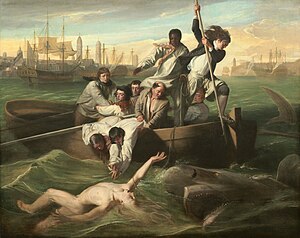Watson and the Shark

|
| Watson and the Shark ( Watson and the Shark ) |
|---|
| John Singleton Copley , 1778 |
| Oil on canvas |
| 182.1 x 229.7 cm |
| National Gallery of Art, Washington, DC |
Watson and the shark (English original title: Watson and the shark ) is a painting by the British-American painter John Singleton Copley . It was created in three very similar versions between 1778 and 1782, which are now exhibited in three museums in the United States of America .
Image description
The painting shows a shark attack in the sea against the backdrop of a harbor. In the foreground, a man floating in the water is attacked by a large, gray shark , the right leg has already been torn off below the knee. In a boat that comes to the man's aid there are nine men, two of whom want to help the injured man floating in the water into the boat, while another throws him a rope and a third attacks the shark with a ship's hook . The rest of the sailors sit at the helm and watch the scene with their eyes wide with terror.
The background of the picture is formed by a harbor with several large sailing ships. Except for two large towers crowned with crosses, the port buildings are only indistinctly shown. These in turn stand in the midst of several masts of the adjacent ships, none of which can be recognized by name.
Image versions
The earliest version of the picture dates back to 1778 and is now owned by the National Gallery of Art in Washington, DC In the same year, Copley painted another version of the picture that can be viewed today at the Museum of Fine Arts in Boston . The two versions of the picture from 1778 differ very little from each other, for example in the shape of the shark's nostrils, the waves or similar details.
The later version from 1782 has a different format and is much smaller. In contrast to the two earlier versions, the picture was taken in portrait format, which gave the sky in particular more space. This sky in particular is also made darker to underline the threat in the scene.
| painting | year | size | museum |
|---|---|---|---|

|
1778 | 182.1 x 229.7 cm | National Gallery of Art , Washington, DC |

|
1778 | 182.9 x 229.2 cm | Museum of Fine Arts , Boston |

|
1782 | 91.4 x 77.5 cm | The Detroit Institute of Arts , Detroit |
Background and interpretation

The picture was created as a commissioned work by Copley, the client was the businessman Brook Watson . As a 13-year-old cabin boy, he was attacked by a shark in the port of Havana ( Cuba ) and rescued by his companions. Watson survived and lost his right lower leg in the attack, so he had to wear a prosthesis . He became a businessman and gained a great reputation as a banker and politician. In 1796 he was Lord Mayor of London for a year , later he headed the Bank of England .
John Singleton Copley was known and successful as a portrait painter in Boston; Watson and the shark turned its first major order represents as a history painter. Unlike established history painting should here but neither a biblical or ancient history or epic represented, but a real story in which the heroes were ordinary people. Benjamin West had already removed the historical genre from the reception of antiquity with his painting The Death of General Wolfe , but Copley's step continued with the choice of motif.
literature
- Thomas W. Gaethgens: Pictures from the New World. American painting of the 18th and 19th centuries. Prestel-Verlag 1988. ISBN 3-7913-0879-3
- Stephan Koja: America. The New World in 19th Century Pictures. Prestel-Verlag 1999. ISBN 3-7913-2051-3
Web links
- Watson and the Shark. National Gallery of Art, Washington, DC (2006)
- The Collection: Watson and the Shark. National Gallery of Art, Washington, DC (2006)
- Watson and the Shark Museum of Fine Arts, Boston (2003)